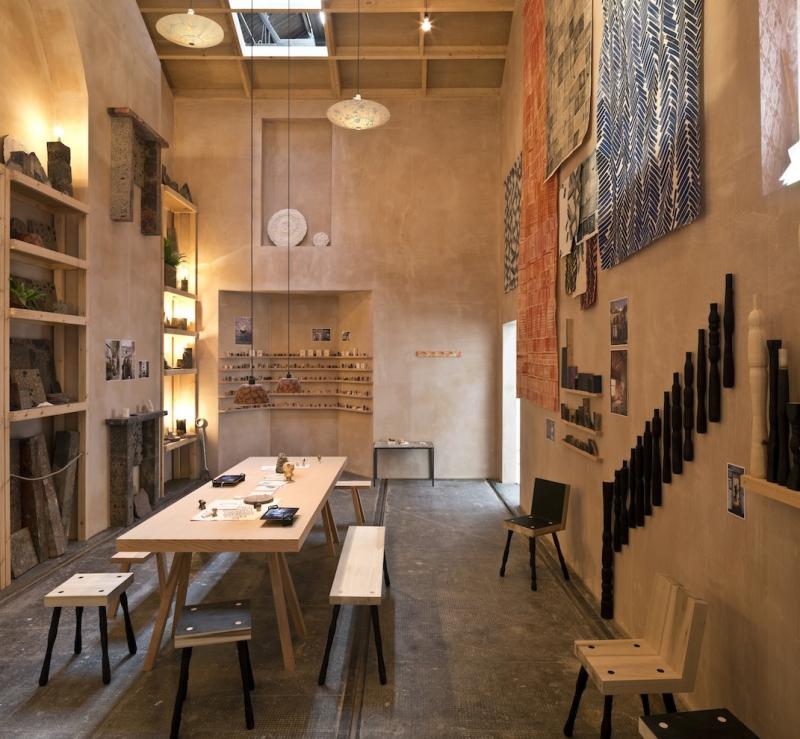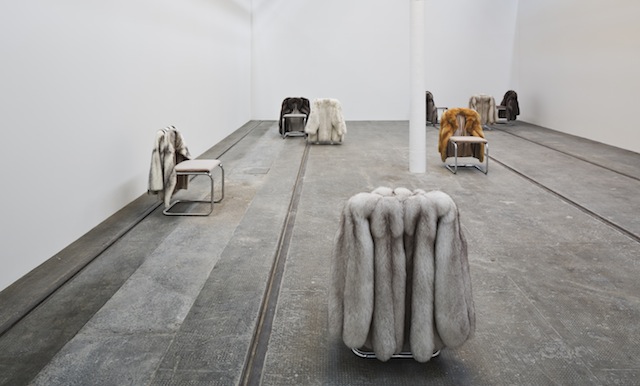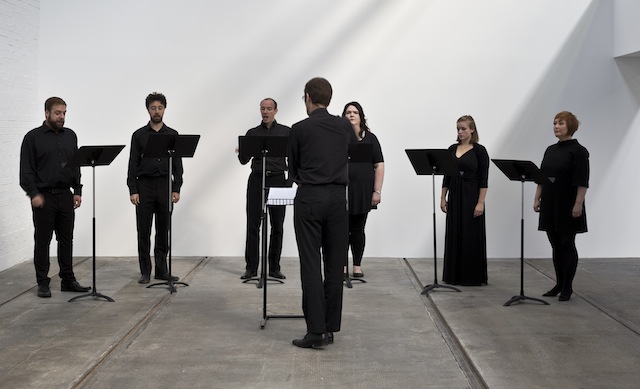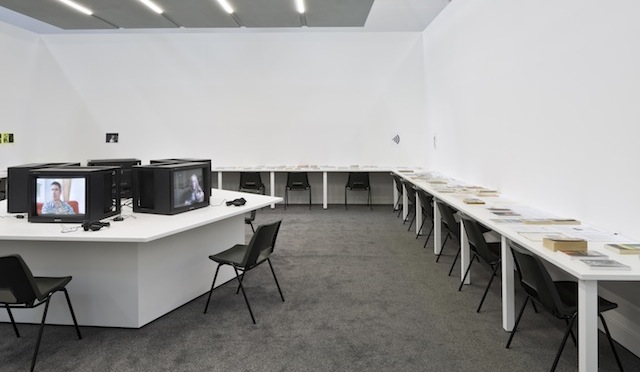Turner Prize 2015, Tramway, Glasgow | reviews, news & interviews
Turner Prize 2015, Tramway, Glasgow
Turner Prize 2015, Tramway, Glasgow
Will the house renovators win? Or is it the Turner Prize that needs a makeover?

What’s going on? It seems the Turner Prize judges not only ran out of Scots to nominate this year, but actual artists. The socially enterprising architect-design collective Assemble don’t even call themselves artists so what must they make of the novelty of being shortlisted for the UK’s premier contemporary art prize? I’ve no doubt they’re delighted, especially since they appear favourites to win, but what a turn up.
Perhaps far more of a novelty though, is the lack of Glasgow School of Art alumni. Scotland’s art colleges throw up Turner Prize winners and nominees as predictably as the yearly pooh-poohing of the prize (see here for my review last year), and none more so than the prestigious Glasgow school, so it’s not without some irony that this year’s host city won’t be celebrating with a homecoming.
The line-up, alas, is not a strong one, even less so than in previous years, and this may or may not have much to do with a lack of Scots. The weakest artist by a far is Nicole Wermers, and I’m really not sure how she came to be nominated. Just how much art did the judges get round to seeing if Wermers and a bunch of house renovators – sorry, I did mean credible community-based-activist urban regenerators – are the result?
For Wermers’ display we find a group of tubular steel modernist chairs arranged in forlorn “conversational” groups, with two placed conspicuously on their own. Fur coats are draped over the backs of each chair (Infrastrukture pictured below). It looks as if a glamorous but unhappy party of identikit fashion models have taken a fag break from a Robert Palmer video. But there’s more to it. The backs of the chairs have actually been removed and the fur coats stitched in their place, so the animal pelts and the leather upholstery unite as one.
 The allusive piece is either far too subtle or possibly all too obvious: luxury goods as art, consumerism and gender dynamics (feminine furs and hard, masculine leather-and-steel modernism?) but the ideas are too thin to have much traction. This really is a conceptually second-rate work.
The allusive piece is either far too subtle or possibly all too obvious: luxury goods as art, consumerism and gender dynamics (feminine furs and hard, masculine leather-and-steel modernism?) but the ideas are too thin to have much traction. This really is a conceptually second-rate work.
Singers are nothing new to the Turner Prize. Scottish artist Susan Philipsz won in 2010 with a recorded rendition of traditional Scottish ballads, and now we have Janice Kerbel’s song cycle for six classical singers (DOUG pictured below) whose elastic vocal chords are stretched to remarkable effect – to my untuned ears one male singer appears to go from “castrato” to bass in under a minute.
 They’re singing Kerbel’s poems about absurd accidents and incidents the body is prone to – falling, slipping etc - but you can’t understand a word of what's being sung. And the piece is awfully, frightfully whimsical and protracted in its earnest comedy. Full credit to the singers though.
They’re singing Kerbel’s poems about absurd accidents and incidents the body is prone to – falling, slipping etc - but you can’t understand a word of what's being sung. And the piece is awfully, frightfully whimsical and protracted in its earnest comedy. Full credit to the singers though.
If Bonnie Camplin’s The Military Industrial Complex (Patterns) sounds ominous it certainly looks dry and theory-heavy (pictured below). At least initially. You’ll find a books on esoteric philosophy and the nature of reality beyond the bounds of physics, arranged on tables like flea market stock, a photocopier to print pages that take your fancy and five TV monitors arranged conference-like on a round table in the centre of the room. But then you pop on headphones and watch people share weird experiences and off-the-radar conspiracy theories. One woman mentions reptiles and the Rothschilds in the same breath, so you know where that might be heading. And if you’re in any doubt she then tells us that “the Nazi influence is heavy in my family”. It gets a lot weirder, but then this is really the stuff of Susan Hiller alien abduction territory, though far less aesthetically compelling. And perversely it’s all a little too “out there” to hold much sustained narrative interest.
 Finally, we have the socially conscientious design collective who might just grab the prize, and it'll probably be churlish to begrudge them it. Assemble is a collective of 18 practitioners, all aged 30 or under, who, since they formed five years ago, have been working with residents in rundown communities to refurbish their homes. Tiles, wobbly basins, door knobs, light-fittings made of discarded bric-a-brac, rough-hewn chairs, granite fireplaces and hand-printed fabrics are all examples of work undertaken for residents at Granby Four Streets in Liverpool’s Toxteth.
Finally, we have the socially conscientious design collective who might just grab the prize, and it'll probably be churlish to begrudge them it. Assemble is a collective of 18 practitioners, all aged 30 or under, who, since they formed five years ago, have been working with residents in rundown communities to refurbish their homes. Tiles, wobbly basins, door knobs, light-fittings made of discarded bric-a-brac, rough-hewn chairs, granite fireplaces and hand-printed fabrics are all examples of work undertaken for residents at Granby Four Streets in Liverpool’s Toxteth.
The group clearly work from the premise that restoring civic pride is just as important as restoring homes. And if you don’t find quite the finish you'd expect from a high-end design studio then be inspired by the thought that the wares are created in collaboration with the residents, who are trained in the skills to continue the good work. Besides, it has the community feel-good ethos that’s “very in” right now.
Explore topics
Share this article
The future of Arts Journalism
You can stop theartsdesk.com closing!
We urgently need financing to survive. Our fundraising drive has thus far raised £49,000 but we need to reach £100,000 or we will be forced to close. Please contribute here: https://gofund.me/c3f6033d
And if you can forward this information to anyone who might assist, we’d be grateful.

Subscribe to theartsdesk.com
Thank you for continuing to read our work on theartsdesk.com. For unlimited access to every article in its entirety, including our archive of more than 15,000 pieces, we're asking for £5 per month or £40 per year. We feel it's a very good deal, and hope you do too.
To take a subscription now simply click here.
And if you're looking for that extra gift for a friend or family member, why not treat them to a theartsdesk.com gift subscription?
more Visual arts
 'We are bowled over!' Thank you for your messages of love and support
Much-appreciated words of commendation from readers and the cultural community
'We are bowled over!' Thank you for your messages of love and support
Much-appreciated words of commendation from readers and the cultural community
 Folkestone Triennial 2025 - landscape, seascape, art lovers' escape
Locally rooted festival brings home many but not all global concerns
Folkestone Triennial 2025 - landscape, seascape, art lovers' escape
Locally rooted festival brings home many but not all global concerns
 Sir Brian Clarke (1953-2025) - a personal tribute
Remembering an artist with a gift for the transcendent
Sir Brian Clarke (1953-2025) - a personal tribute
Remembering an artist with a gift for the transcendent
 Emily Kam Kngwarray, Tate Modern review - glimpses of another world
Pictures that are an affirmation of belonging
Emily Kam Kngwarray, Tate Modern review - glimpses of another world
Pictures that are an affirmation of belonging
 Kiefer / Van Gogh, Royal Academy review - a pairing of opposites
Small scale intensity meets large scale melodrama
Kiefer / Van Gogh, Royal Academy review - a pairing of opposites
Small scale intensity meets large scale melodrama
 Jenny Saville: The Anatomy of Painting, National Portrait Gallery review - a protégé losing her way
A brilliant painter in search of a worthwhile subject
Jenny Saville: The Anatomy of Painting, National Portrait Gallery review - a protégé losing her way
A brilliant painter in search of a worthwhile subject
 Abstract Erotic, Courtauld Gallery review - sculpture that is sensuous, funny and subversive
Testing the boundaries of good taste, and winning
Abstract Erotic, Courtauld Gallery review - sculpture that is sensuous, funny and subversive
Testing the boundaries of good taste, and winning
 Edward Burra, Tate Britain review - watercolour made mainstream
Social satire with a nasty bite
Edward Burra, Tate Britain review - watercolour made mainstream
Social satire with a nasty bite
 Ithell Colquhoun, Tate Britain review - revelations of a weird and wonderful world
Emanations from the unconscious
Ithell Colquhoun, Tate Britain review - revelations of a weird and wonderful world
Emanations from the unconscious
 Rachel Jones: Gated Canyons, Dulwich Picture Gallery review - teeth with a real bite
Mouths have never looked so good
Rachel Jones: Gated Canyons, Dulwich Picture Gallery review - teeth with a real bite
Mouths have never looked so good
 Yoshitomo Nara, Hayward Gallery review - sickeningly cute kids
How to make millions out of kitsch
Yoshitomo Nara, Hayward Gallery review - sickeningly cute kids
How to make millions out of kitsch
 Hamad Butt: Apprehensions, Whitechapel Gallery review - cool, calm and potentially lethal
The YBA who didn’t have time to become a household name
Hamad Butt: Apprehensions, Whitechapel Gallery review - cool, calm and potentially lethal
The YBA who didn’t have time to become a household name

Add comment